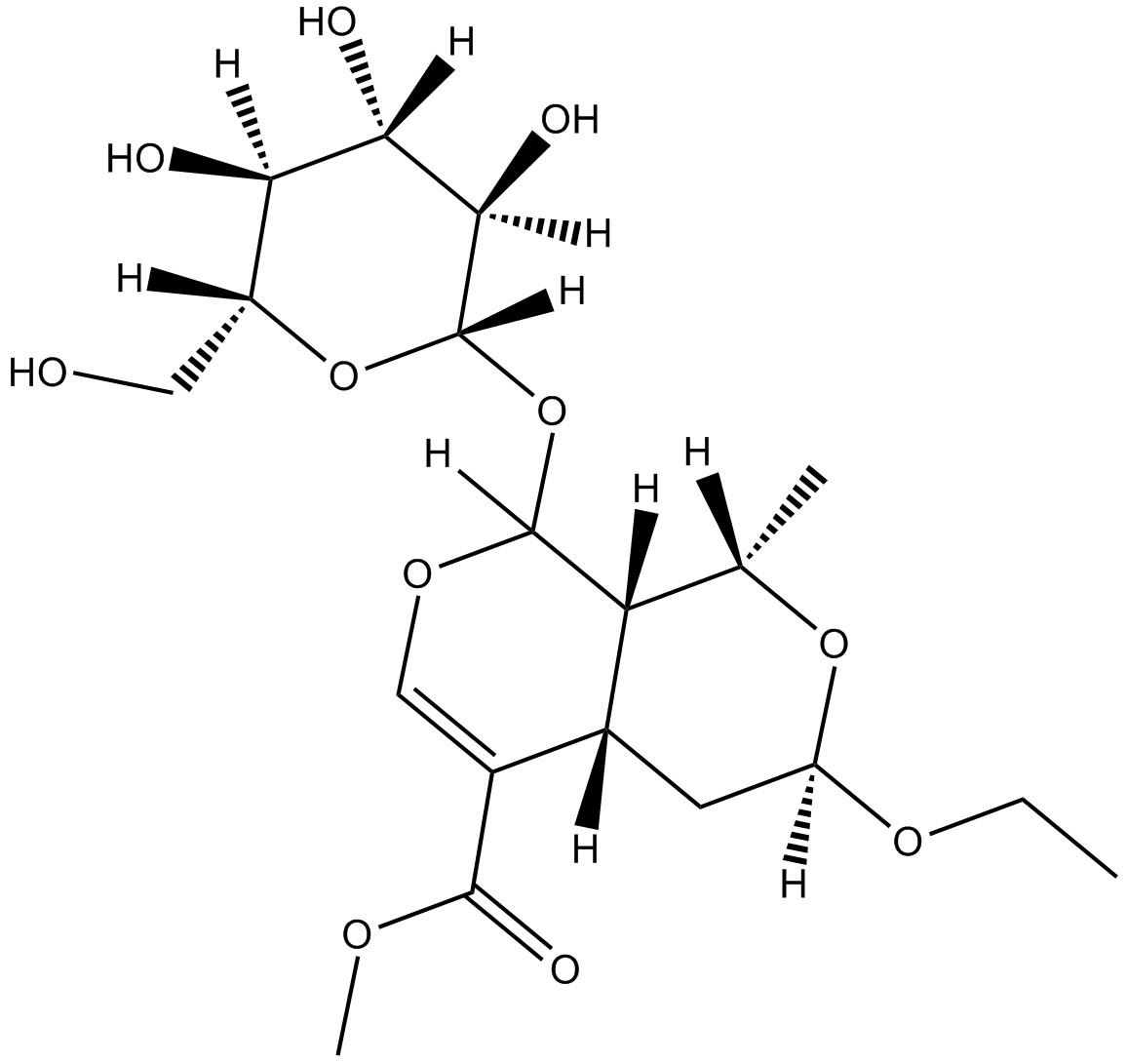Natural Products
Produkte für Natural Products
- Bestell-Nr. Artikelname Informationen
-
GC35137
4'-Methoxyresveratrol
4'-Methoxyresveratrol (4'-O-Methylresveratrol) ist ein aus Dipterocarpaceae gewonnenes Polyphenol mit antiandrogener, antimykotischer und entzÜndungshemmender Wirkung.
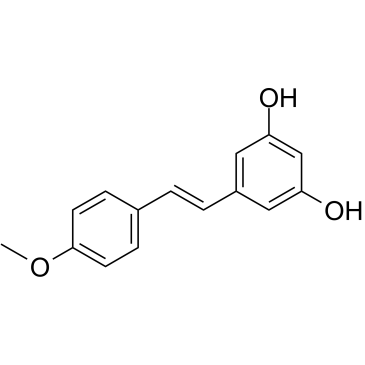
-
GC35145
4'-O-Methylochnaflavone
4'-O-Methylochnaflavon ist ein aus Lonicera japonica isoliertes Biflavonoid, das die Proliferation von Mauslymphozyten unterdrÜckt.
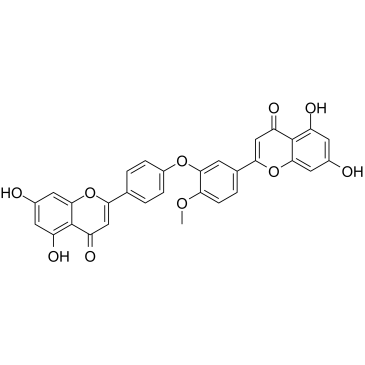
-
GC30193
4-Allylcatechol (4-Allylpyrocatechol)
4-Allylcatechol (4-Allylpyrocatechol) (4-Allylpyrocatechol, Hydroxychavicol) ist ein Zwischenprodukt fÜr synthetisches Safrol.
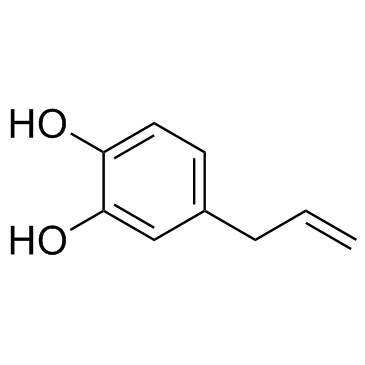
-
GC61659
4-Allyltoluene
4-Allyltoluol, eine aromatische Verbindung, kann eine sensorische olfaktorische Reaktion der mediterranen Fruchtfliege hervorrufen, gemessen durch Elektroantennographie (EAG).
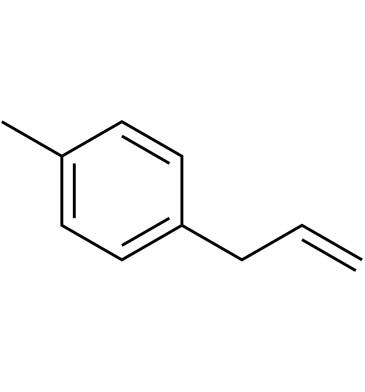
-
GC61657
4-Aminobenzaldehyde
4-Aminobenzaldehyd (p-Aminobenzaldehyd) ist ein nÜtzliches synthetisches Reagenz und Monomer, das zur Synthese von Monoazofarbstoffen und photohÄrtbaren Ionenaustauscherharzen verwendet werden kann.
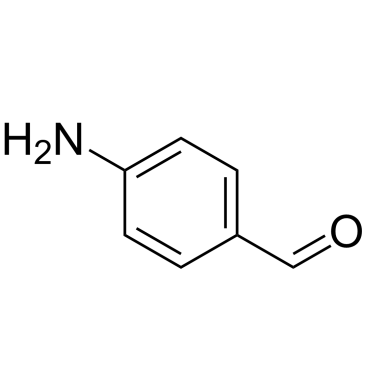
-
GC42363
4-chloro-α-Cyanocinnamic Acid
4-chloro-α-cyanocinnamic acid (Cl-CCA) is a phenylpropanoid, related to cinnamic acid, which is synthesized by plants from phenylalanine.

-
GC40987
4-deoxy-4α-Phorbol
4-deoxy-4α-Phorbol is a tetracyclic diterpene found in croton oil.

-
GC61688
4-Ethylresorcinol
4-Ethylresorcin, ein Derivat von Resorcin, kann als Substrat von Tyrosinase wirken.
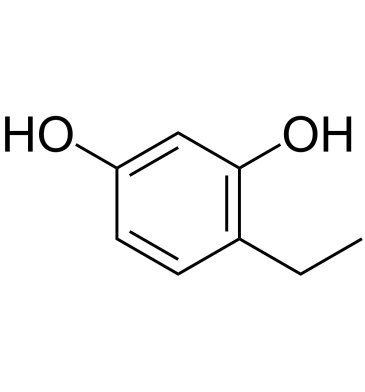
-
GC61928
4-Hydroxy-1H-indole-3-carbaldehyde
4-Hydroxy-1H-indol-3-carbaldehyd ist ein Pflanzenmetabolit, der in Capparis spinosa L.
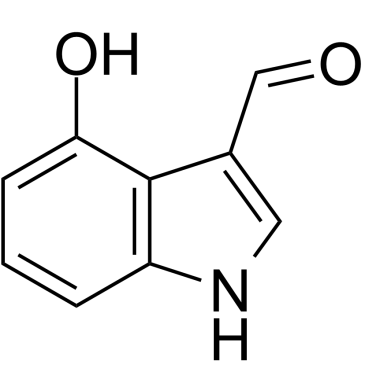
-
GC41375
4-Hydroxy-6-methyl-2-pyrone
4-Hydroxy-6-methyl-2-pyrone is a fungal metabolite that has been isolated from H.

-
GC48898
4-Hydroxycanthin-6-one
An alkaloid

-
GN10101
4-hydroxyephedrine hydrochloride
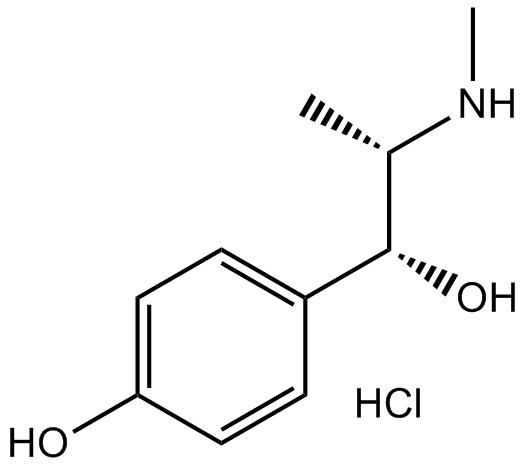
-
GN10060
4-Hydroxyisoleucine
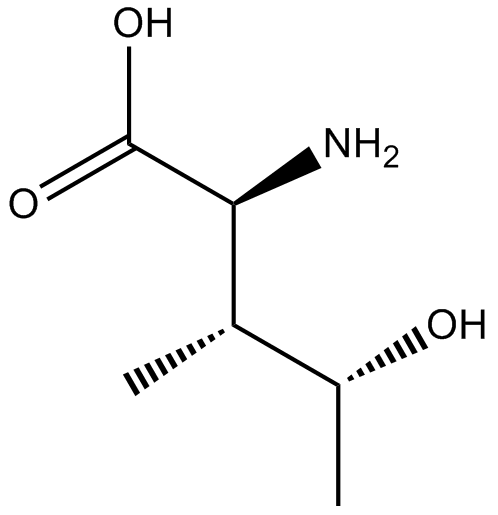
-
GC42434
4-methyl-2-Oxovalerate (sodium salt)
4-methyl-2-Oxovalerate is an immediate precursor and metabolite of L-leucine.

-
GC61654
4-Methyl-5,6,7,8-tetrahydroquinoline
4-Methyl-5,6,7,8-tetrahydrochinolin, ein Tetrahydrochinolin-Alkaloid, wird aus den Wurzeln von Glycyrrhiza uralensis Fisch isoliert.
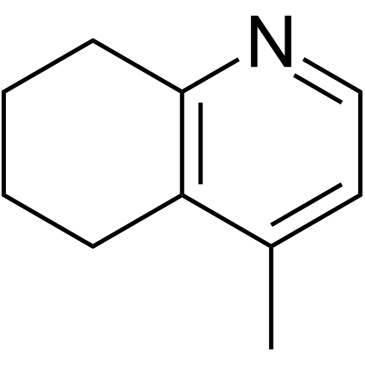
-
GC48854
4-Methylthiocanthin-6-one
An alkaloid

-
GC30519
4-Methylumbelliferyl-β-D-glucuronide hydrate (MUG)
4-Methylumbelliferyl-β-D-glucuronidhydrat (MUG) ist ein fluorogenes Substrat (Λex=362 nm, Λem=445 nm).
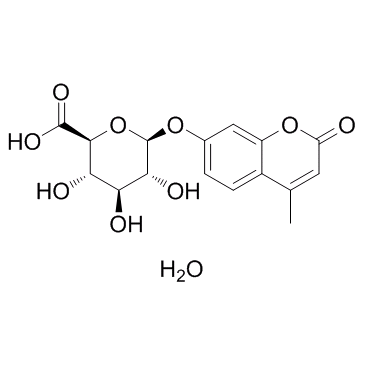
-
GC35142
4-O-beta-Glucopyranosyl-cis-coumaric acid
4-O-beta-Glucopyranosyl-cis-cumarsÄure ist eine natÜrliche Verbindung, die aus Nelumbo nucifera Gaertn isoliert wurde.
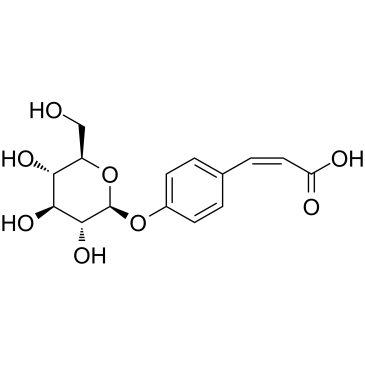
-
GC32153
5α-Pregnane-3β,6α-diol-20-one
5α-Pregnane-3β,6α-diol-20-one ist ein mitogener Metabolit von Progesteron und kann in ausgehungerten Androgen-responsiven Prostatakrebszellen produziert werden.
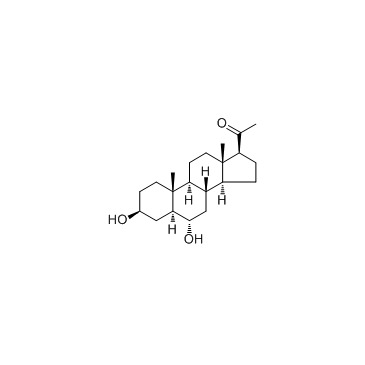
-
GC48381
5'-pApA (sodium salt)
A linearized form of cyclic di-AMP

-
GC30302
5(6)-Aminofluorescein (5(6)-AFM)
5(6)-Aminofluorescein (5(6)-AFM) (5(6)-AFM) ist ein VorlÄufer fÜr die Synthese von 5(6)-FITC.
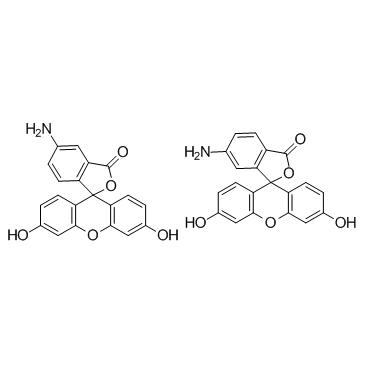
-
GC30217
5(6)-Carboxyfluorescein (5(6)-FAM)
5(6)-Carboxyfluorescein (5(6)-FAM) (5(6)-FAM) ist eine aminreaktive, pH-empfindliche, grÜn fluoreszierende Sonde. 5(6)-Carboxyfluorescein (5(6)-FAM) (5(6)-FAM) kann zur Markierung von Proteinen, Peptiden und Nukleotiden verwendet werden. 5(6)-Carboxyfluorescein (5(6)-FAM) kann zum Nachweis von Tumorarealen in vivo verwendet werden.
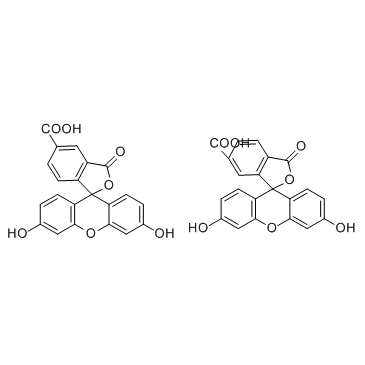
-
GC33435
5(6)-CFDA
5(6)-CFDA (5-(6)-Carboxyfluoresceindiacetat) ist eine zellgÄngige, aminreaktive grÜn fluoreszierende Sonde, die zur FÄrbung von Zellen fÜr die Analyse in Anwendungen verwendet wird.
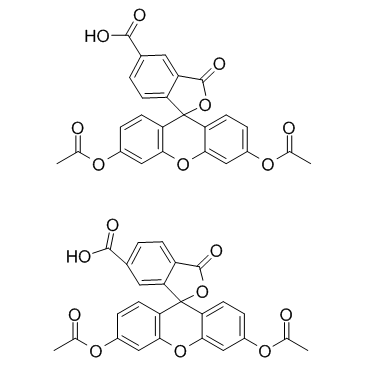
-
GC33461
5(6)-FAM SE
5(6)-FAM SE ist ein Amin-reaktiver grÜner Fluoreszenzfarbstoff, der hÄufig zur Markierung von Proteinen oder anderen MolekÜlen verwendet wird, die ein primÄres oder sekundÄres aliphatisches Amin enthalten.
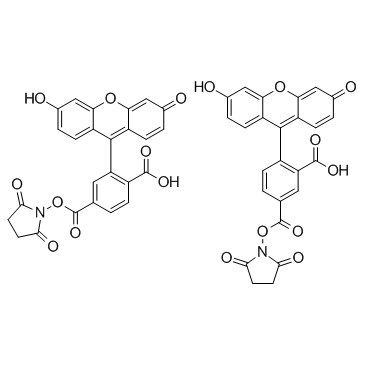
-
GC33440
5(6)-FITC
5(6)-FITC (Fluorescein 5(6)-isothiocyanate) ist ein Amin-reaktives Derivat des Fluorescein-Farbstoffs, das weitreichende Anwendungen als Marker fÜr AntikÖrper und andere Sonden hat, zur Verwendung in der Fluoreszenzmikroskopie, Durchflusszytometrie und Immunfluoreszenz- basierte Assays wie Western Blotting und ELISA.
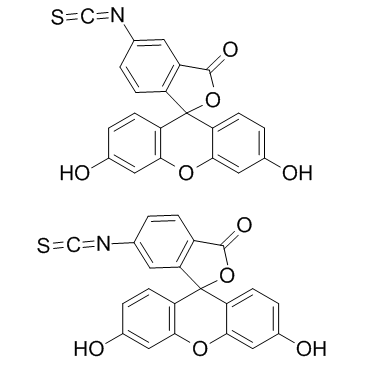
-
GC30339
5(6)-ROX (5(6)-Carboxy-X-rhodamine)
5(6)-ROX (5(6)-Carboxy-X-rhodamin) ist eine NukleinsÄure-Fluoreszenzmarkierung, die als Referenzfarbstoff fÜr die Echtzeit-Polymerase-Kettenreaktion verwendet werden kann.
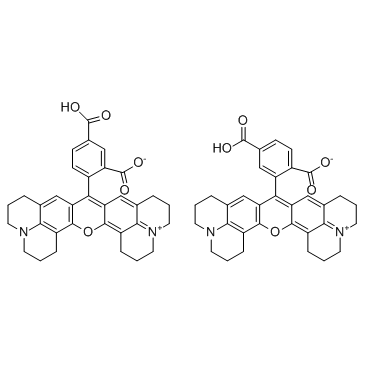
-
GC30089
5(6)-TAMRA (5(6)-Carboxytetramethylrhodamine)
5(6)-TAMRA (5(6)-Carboxytetramethylrhodamin) enthält eine Carbonsäure, die zur Reaktion mit primären Aminen über Carbodiimid-Aktivierung der Carbonsäure verwendet werden kann. Der leuchtend orange-fluoreszierende Farbstoff produziert Konjugate mit Absorptions-/Emissionsmaxima von ~555/580 nm.
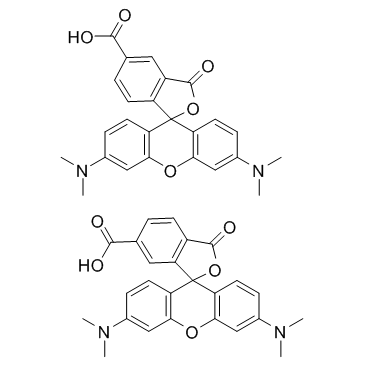
-
GC30157
5(6)-TAMRA SE (5(6)-Carboxytetramethylrhodamine N-succinimidyl ester)
5(6)-TAMRA SE (5(6)-Carboxytetramethylrhodamin-N-succinimidylester) ist die Amin-reaktive, gemischtisomere Form von TAMRA, einem Farbstoff fÜr die Oligonukleotidmarkierung und automatisierte DNA-Sequenzierungsanwendungen.
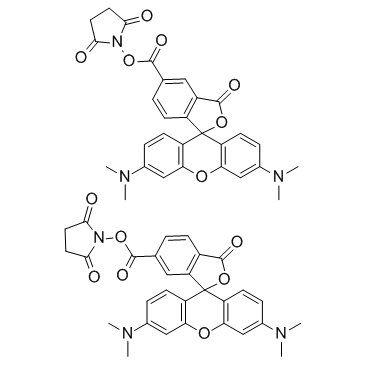
-
GN10153
5,15-Diacetyl-3-benzoyllathyrol
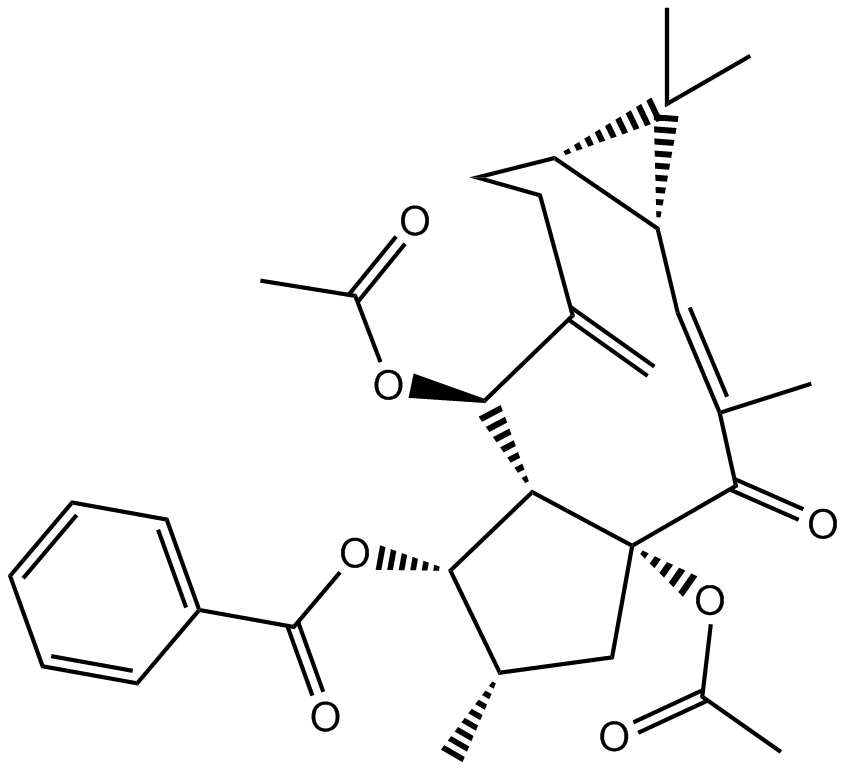
-
GC35148
5,6,7,40-Tetrahydroxyisoflavone-6,7-di-o-b-D-glucopyranoside
5,6,7,40-Tetrahydroxyisoflavon-6,7-di-o-b-D-glucopyranosid ist ein aus Pueraria lobata isoliertes Isoflavonoid-Glycosid.
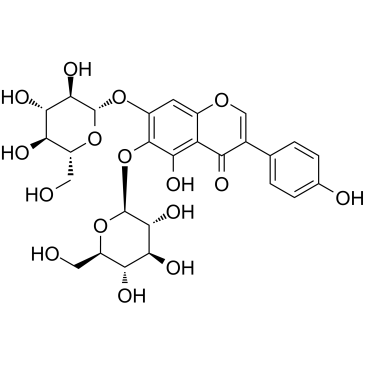
-
GC35151
5,6-Didehydroginsenoside Rd
5,6-Didehydroginsenosid Rd ist ein Saponin vom Dammaran-Typ, das aus den getrockneten Wurzeln von Panax Notoginseng isoliert wird.
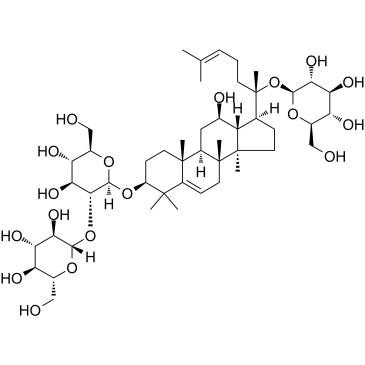
-
GC35149
5,7,3'-Trihydroxy-6,4',5'-trimethoxyflavone
5,7,3'-Trihydroxy-6,4',5'-trimethoxyflavon ist ein methyliertes Flavon aus Artemisia frigida.
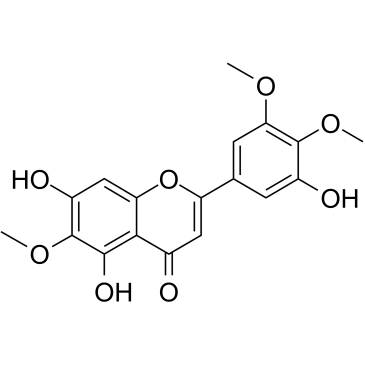
-
GC35154
5,7,4'-Trihydroxy-8-Methylflavanone
5,7,4'-Trihydroxy-8-Methylflavanon (Verbindung 2) ist ein aus Qualea grandiflora isoliertes Flavanon.
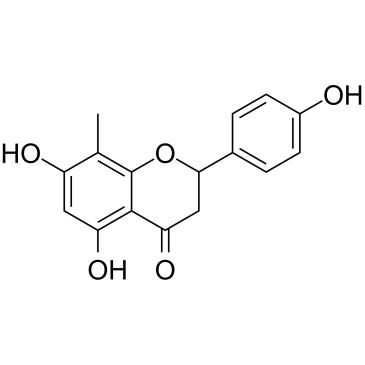
-
GC60526
5,7,8-Trimethoxyflavone
5,7,8-Trimethoxyflavon (Norwogonin 5,7,8-Trimethylether), isoliert aus Andrographis echioides, hemmt NO mit einem IC50 von 39,1 μM.
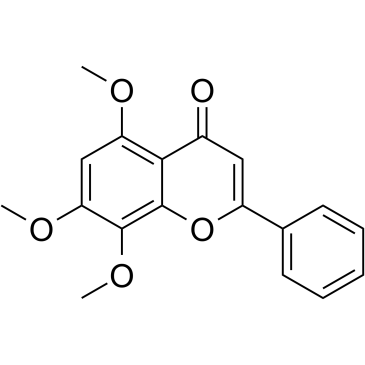
-
GC30107
5-Aminofluorescein (5-AF)
5-Aminofluorescein (5-AF) (5-AF) ist ein Fluoreszenzmarker, der kovalent an Humanserumalbumin gebunden ist.
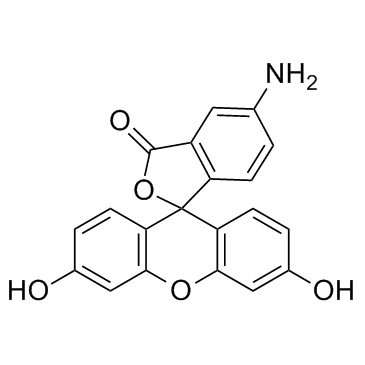
-
GC33489
5-CFDA (5-Carboxyfluorescein diacetate)
5-CFDA (5-Carboxyfluoresceindiacetat)(5-Carboxyfluoresceindiacetat) ist membrangÄngig und kann durch Inkubation in Zellen geladen werden; durch intrazellulÄre Esterasen zu 5-Carboxyfluorescein hydrolysiert; zur Markierung menschlicher Bandscheibenzellen in vitro fÜr die Fluoreszenzmikroskopie verwendet.
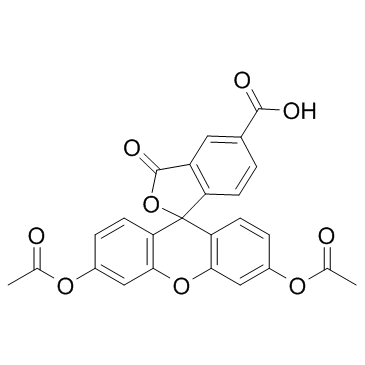
-
GC30102
5-FAM (5-Carboxyfluorescein)
5-FAM (5-Carboxyfluorescein) (5-Carboxyfluorescein) ist ein grÜn fluoreszierendes Reagenz, das zur In-situ-Markierung von Peptiden, Proteinen und Nukleotiden verwendet wird.
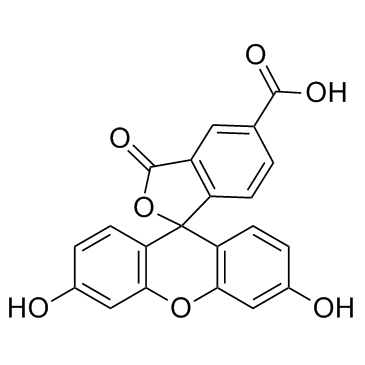
-
GC30174
5-FAM SE
5-FAM SE ist ein einzelnes Isomer, ein fluoreszierendes Markierungsreagenz, das zur Markierung von Peptiden, Proteinen und Nukleotiden verwendet wird.
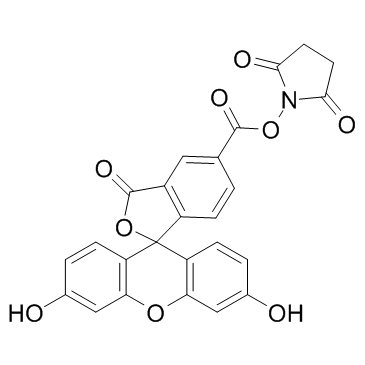
-
GC49233
5-Feruloylquinic Acid
5-FeruloylchinasÄure (5-FQA) besitzt antioxidative Wirkungen und tyrosinasehemmende AktivitÄten.

-
GN10062
5-HTP

-
GC35161
5-Hydroxy-7-acetoxyflavone
5-Hydroxy-7-acetoxyflavon, ein aktives natÜrliches Flavonderivat, das in verschiedenen Pflanzenquellen vorkommt, moduliert mehrere biologische AktivitÄten.
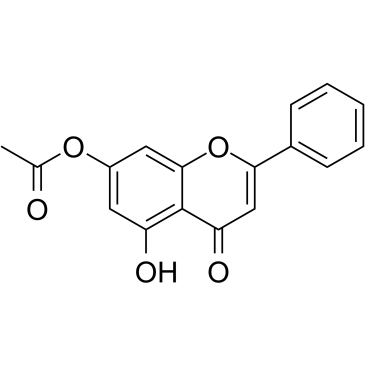
-
GC42553
5-hydroxy-Nω-methyl Tryptamine (oxalate)
5-hydroxy-Nω-methyl Tryptamine is a metabolite of serotonin in humans that has also been found in plants.

-
GC39692
5-Hydroxyflavone
5-Hydroxyflavon, ein Flavonoidligand, zeigt keine zytotoxische AktivitÄt gegen MCF-7-, FaDU-, MDA-MB-435S-, U87-, RPE-1- und HEK293-Zellen.
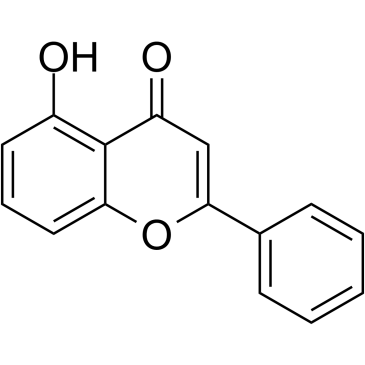
-
GN10111
5-hydroxymethyl-2-furaldehyde
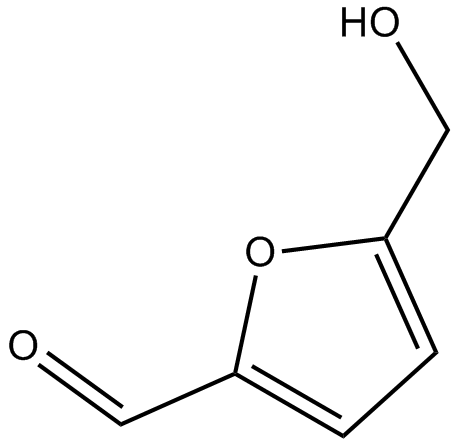
-
GC34180
5-IAF (5-Iodoacetamidofluorescein)
5-IAF (5-Iodacetamidofluorescein) ist ein Idoacetamid-Derivat von Fluorescein.
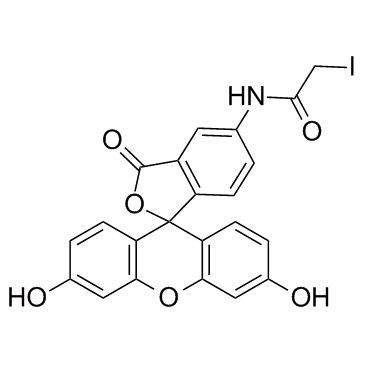
-
GN10241
5-Methoxypsoralen
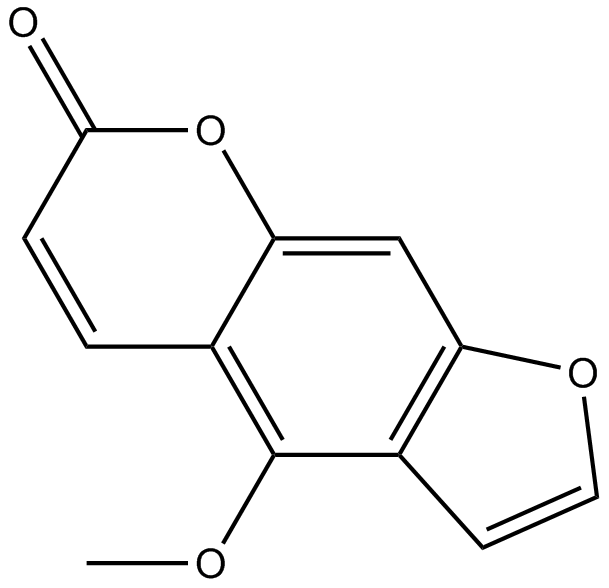
-
GC35164
5-Methoxysalicylic acid
5-MethoxysalicylsÄure (5-MeOSA) ist eine natÜrliche Verbindung, die in Kombination mit Spermin als nÜtzliche Matrix bei der MALDI-MS-Analyse von Oligonukleotiden verwendet wird.
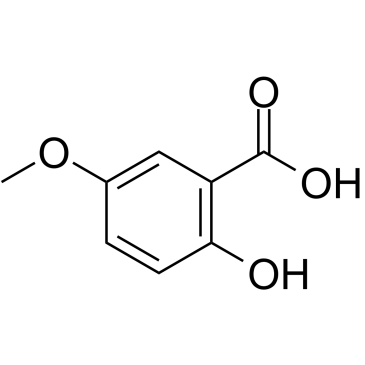
-
GC39693
5-Methyl-2-thiophenecarboxaldehyde
5-Methyl-2-thiophencarboxaldehyd fungiert als Kandidat fÜr mikroskopisches nichtlineares optisches Material (NLO) dritter Ordnung.
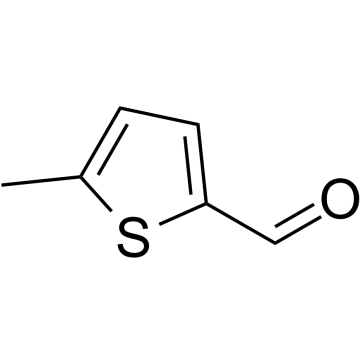
-
GC35165
5-Methyl-7-methoxyisoflavone
5-Methyl-7-methoxyisoflavone ist ein sensationelles, nichtsteroidales anaboles Isoflavon.
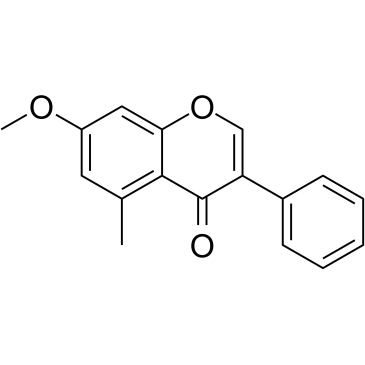
-
GN10525
5-O-Methylvisammioside
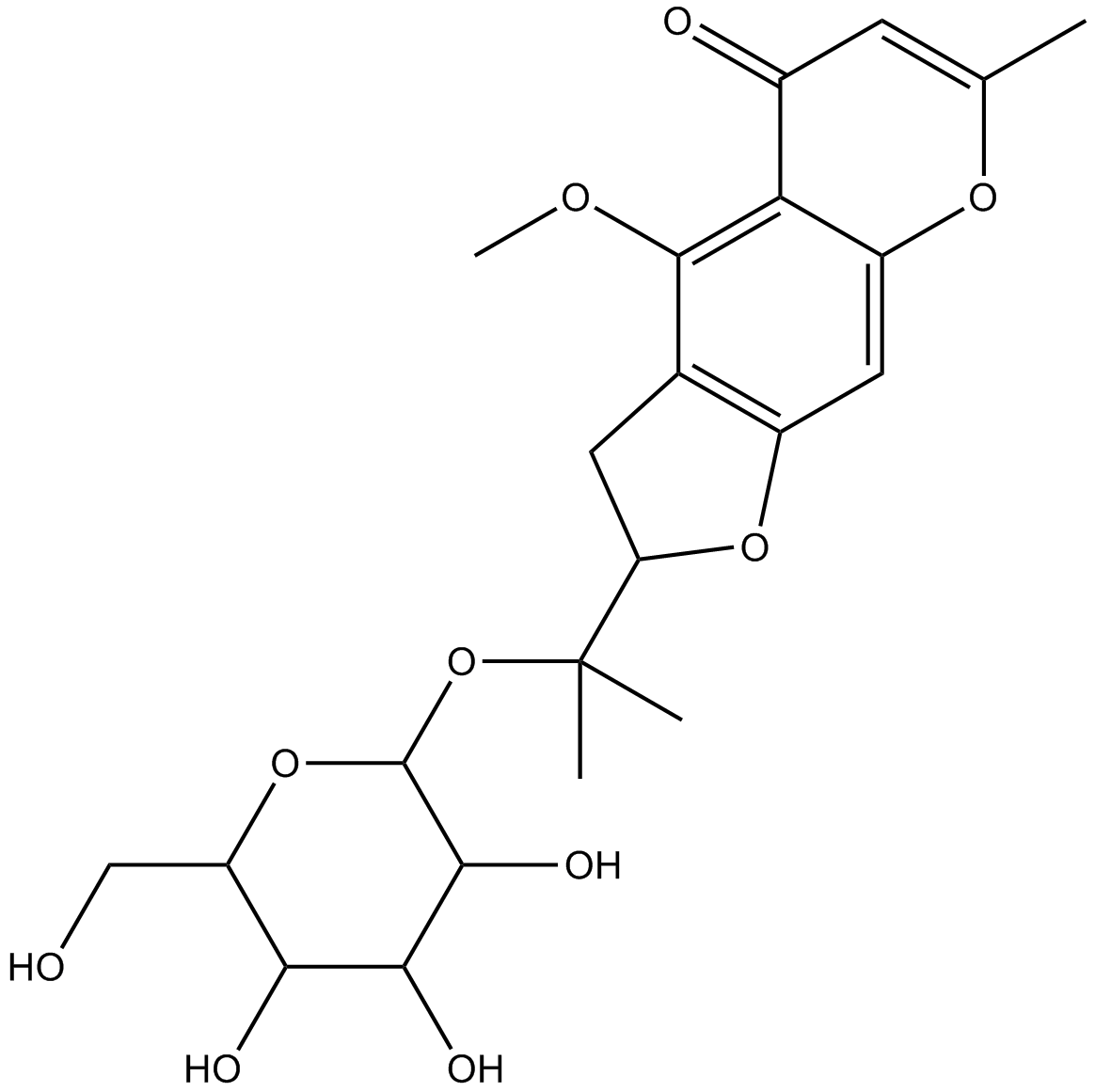
-
GC46712
5-Phenyllevulinic Acid
A fungal metabolite

-
GC46713
5-Phospho-D-ribose 1-diphosphate (sodium salt hydrate)
An intermediate in several biochemical pathways
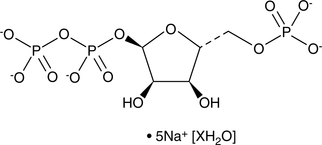
-
GC15796
5-ROX
5-ROX (5-Carboxy-X-rhodamin), ein Rhodamin-Farbstoff, zeigt in wÄssrigem Puffer eine starke Fluoreszenzeigenschaft mit einem Λ-Austritt von 580 nm (ε=3,6 × 104 M-1 cm-1) und einem Λ-Emit von 604 nm ( ϕ=0,94).

-
GC30444
5-TAMRA (5-Carboxytetramethylrhodamine)
5-TAMRA (5-Carboxytetramethylrhodamin) (5-Carboxytetramethylrhodamin), SE und seine Konjugate ergeben eine helle, pH-unempfindliche orangerote Fluoreszenz (ungefÄhre Anregungs-/Emissionsmaxima ~546/579) mit guter PhotostabilitÄt.
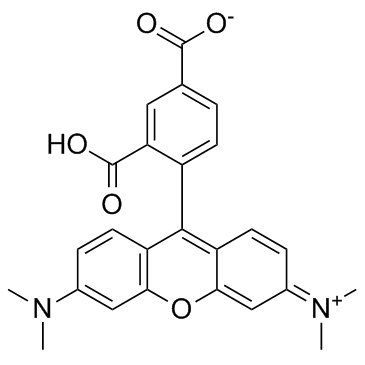
-
GC30099
5-TAMRA-SE (5-TAMRA-NHS ester)
5-TAMRA-SE (5-TAMRA-NHS-Ester) ist ein Amin-reaktiver Fluoreszenzstoff, seine Konjugate ergeben eine helle, pH-unempfindliche orange-rote Fluoreszenz (ungefÄhre Anregungs-/Emissionsmaxima ~546/579) mit guter PhotostabilitÄt.
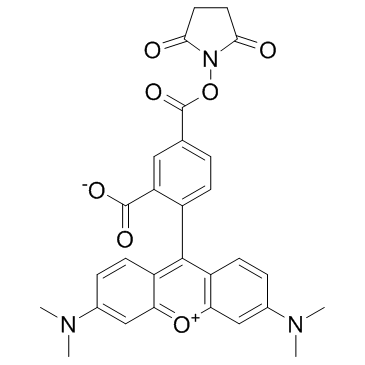
-
GC39585
6"-O-Acetyldaidzin
6"-O-Acetyldaidzin ist ein aus Sojabohnen isoliertes Isoflavonglykosid.
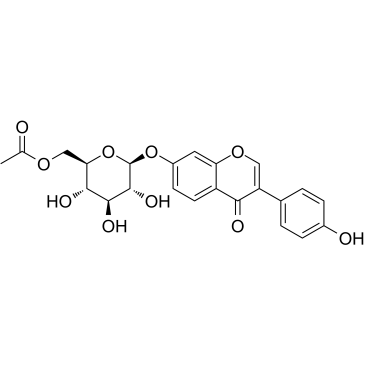
-
GC39694
6"-O-Acetylgenistin
6"-O-Acetylgenistin ist ein aus Sojabohnen isoliertes Isoflavonglykosid.
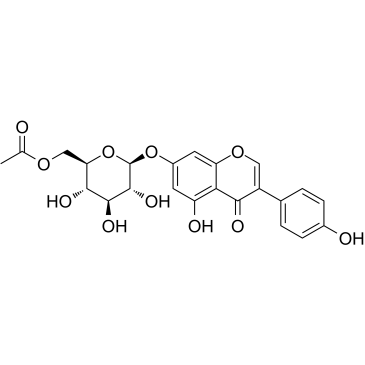
-
GC35172
6"-O-Apiosyl-5-O-Methylvisammioside
6"-O-Apiosyl-5-O-Methylvisammiosid ist einer der Bestandteile der traditionellen chinesischen Medizin Kang-Jing.
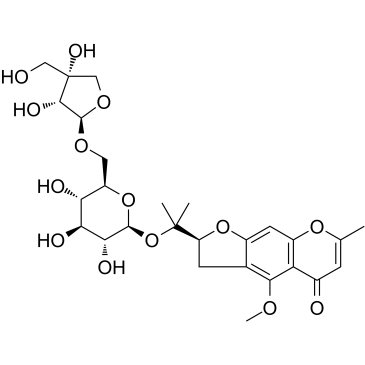
-
GC39586
6"-O-Malonyldaidzin
6"-O-Malonyldaidzin ist ein malonyliertes Isoflavon, das aus Sojabohnensamen isoliert wird.
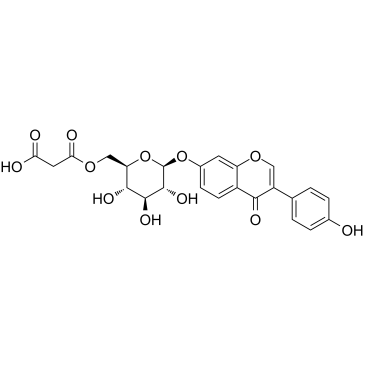
-
GC35181
6''-O-Acetylglycitin
6''-O-Acetylglycitin, ein Acetylglucosid, ist eines der Isoflavon-Isomere in Sojabohnen und zeigt je nach Lagertemperatur, Verpackungszustand und Art des Isoflavon-Isomers verschiedene Ausmaße der Gehaltsreduzierung .
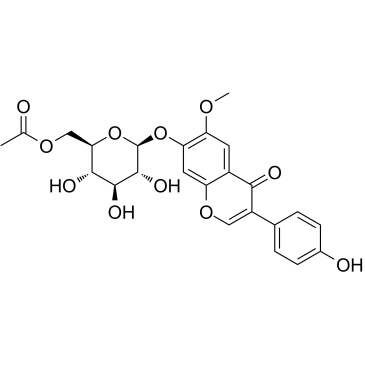
-
GC60534
6''-O-Acetylsaikosaponin A
6''-O-Acetylsaikosaponin A, ein aus den Wurzeln von Bupleurum chinense isoliertes Acetylsaikosaponin, zeigt einige osteoklastenhemmende Wirkungen.
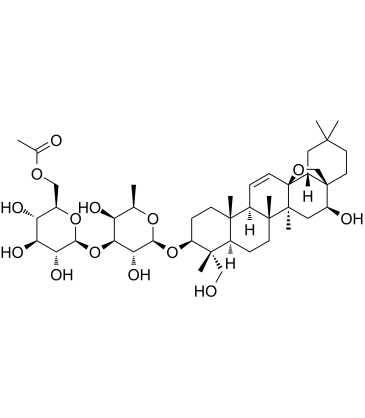
-
GC33568
6''-O-Malonylgenistin (Malonylgenistin)
6''-O-Malonylgenistin (Malonylgenistin) ist ein Derivat von Isoflavon.
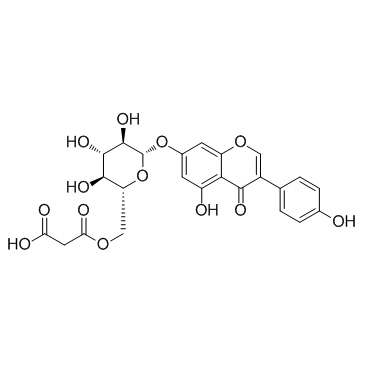
-
GC35182
6'-O-beta-D-Glucosylgentiopicroside
6'-O-beta-D-Glucosylgentiopicrosid ist ein Secoiridoid, das aus den Wurzeln von G.
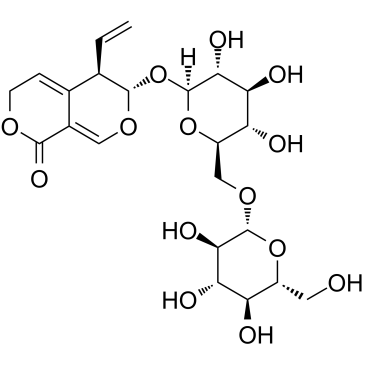
-
GC35170
6'-O-Cinnamoyl harpagide
6'-O-Cinnamoylharpagid ist ein Iridoidglycosid, das aus den Wurzeln von Scrophularia ningpoensis isoliert wird.
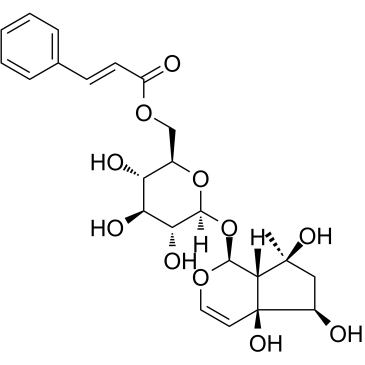
-
GC19536
6'-Sialyllactose Sodium Salt
6'-Sialyllactose (Natrium), ein vorherrschendes Milch-Oligosaccharid, reduziert die Internalisierung von Pseudomonas aeruginosa in menschliche Pneumozyten.

-
GC18512
6,7-dimethyl-8-Ribityllumazine
6,7-Dimethyl-8-Ribityllumazin (DMRL) ist ein natürlicher Chromophor des Lumazine-Proteins (LumP), einem fluoreszierenden Hilfsprotein, das eine Blauverschiebung (495 auf 475 nm) in den Emissionswellenlängen von Luciferase bei biolumineszentem Photobacterium induziert.
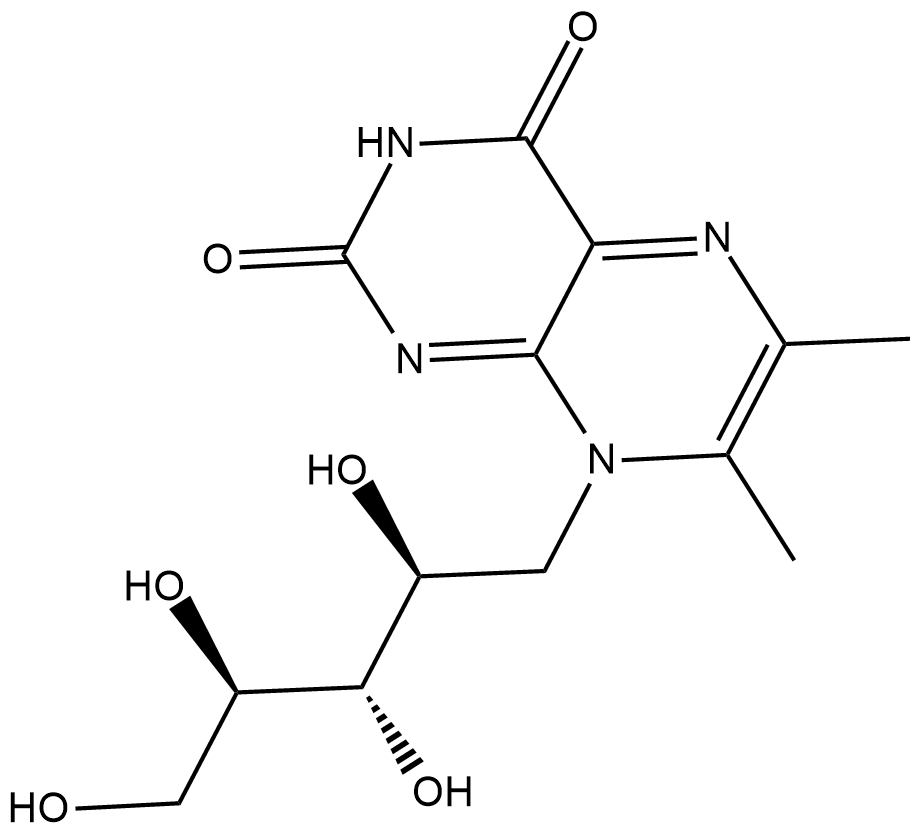
-
GC33611
6-(γ,γ-Dimethylallylamino)purine (N6-(2-lsopentenyl)adenine)
6-(γ,γ-Dimethylallylamino)purin (N6-(2-lsopentenyl)adenin) ist ein Pflanzenwachstumsstoff.
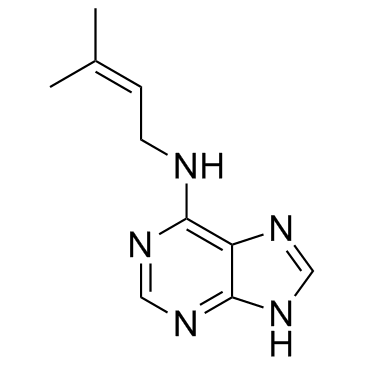
-
GC30123
6-Aminofluorescein (6-AF)
6-Aminofluorescein (6-AF) (6-AF) ist ein neuer Fluoreszenzmarker.
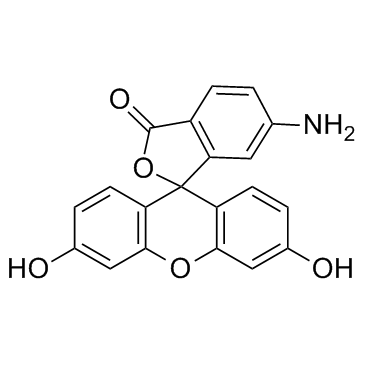
-
GC42574
6-Bromo-2-oxindole
6-Bromo-2-oxindole is a secondary metabolite that has been isolated from the sea squirt (D.

-
GC33332
6-Chloropurine (6-Chloro-9H-purine)
6-Chloropurine (6-Chloro-9H-purine) ist ein Baustein in der chemischen Synthese. Zwischenprodukt bei der Herstellung von 9-Alkylpurinen und 6-Nercaptopurin. Antitumor-AktivitÄten.
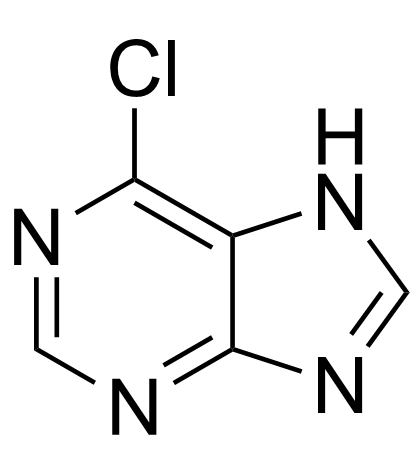
-
GC45955
6-Ethyl-2,7-dimethoxyjuglone
6-Ethyl-2,7-dimethoxyjuglon ist ein aus SÜßwasserpilzen isolierter Metabolit.

-
GC30020
6-FAM (6-Carboxyfluorescein)
6-FAM (6-Carboxyfluorescein) (6-Carboxyfluorescein) enthÄlt eine CarbonsÄure, die verwendet werden kann, um mit primÄren Aminen Über eine Carbodiimid-Aktivierung der CarbonsÄure zu reagieren.
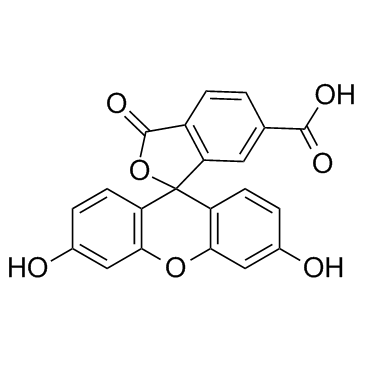
-
GC35173
6-Feruloylspinosin
6-Feruloylspinosin ist ein Flavonoid, das aus Samen von Ziziphus jujuba isoliert wird.
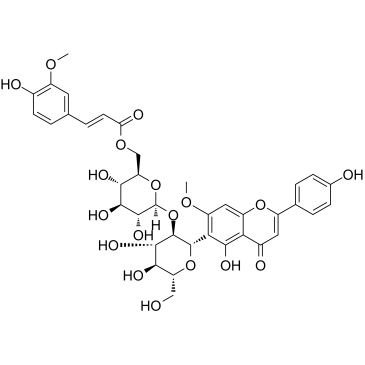
-
GC33556
6-FITC (6-Fluorescein Isothiocyanate)
6-FITC (6-Fluorescein-Isothiocyanat) (6-Fluorescein-Isothiocyanat) ist ein Derivat von Fluorescein, das in zahlreichen Anwendungen einschließlich Durchflusszytometrie verwendet wird.
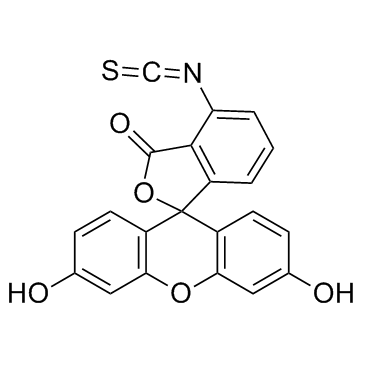
-
GC35176
6-Formyl-isoophiopogonanone A
6-Formyl-isoophiopogonanon A ist ein aus Ophiopogon japonicas extrahiertes Homoisoflavonoid mit antioxidativer AktivitÄt.
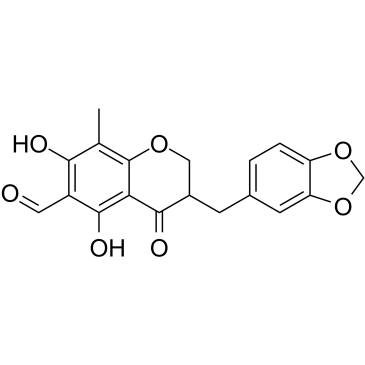
-
GN10093
6-gingerol
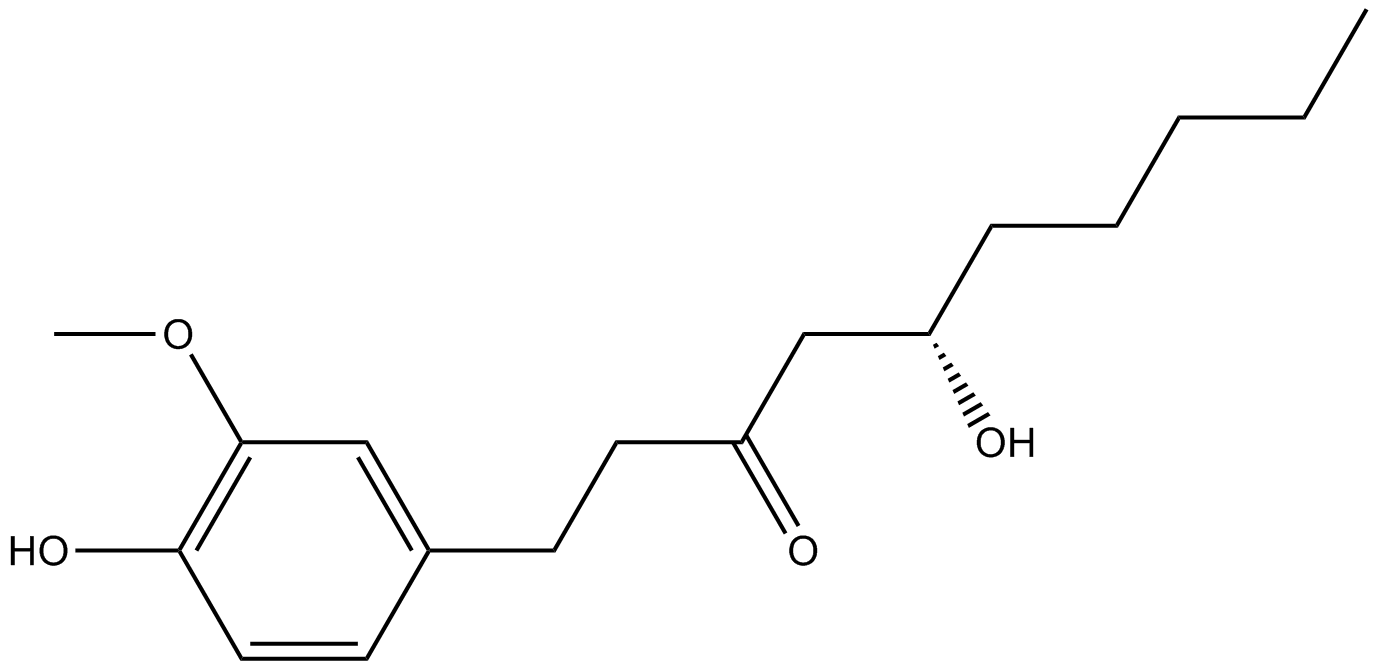
-
GC46723
6-hydroxy Ramulosin
A fungal metabolite

-
GC38240
6-Hydroxy-4-methylcoumarin
6-Hydroxy-4-methylcumarin (Verbindung 9) ist ein sekundÄrer Metabolit des Cumarins und hat AntikrebsaktivitÄt.
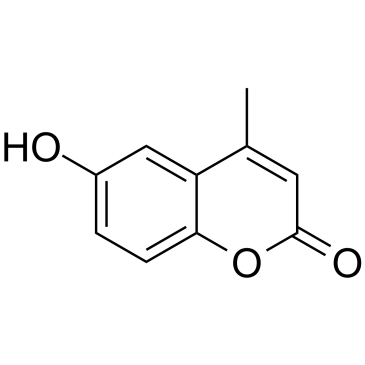
-
GC61660
6-Hydroxycoumarin
6-Hydroxycoumarin ist ein Cumarin mit entzÜndungshemmender, fiebersenkender, antioxidativer, gefÄßerweiternder, antiamÖbischer, antibakterieller, antimykotischer, bakteriostatischer und antitumoraler Wirkung.
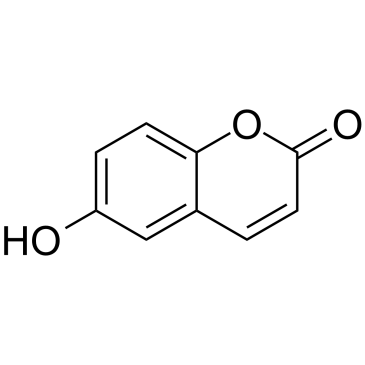
-
GC38142
6-Hydroxyflavone
6-Hydroxyflavon ist ein natÜrlich vorkommendes Flavon mit entzÜndungshemmender Wirkung.

-
GC35177
6-Methoxy Dihydrosanguinarine
6-Methoxydihydrosanguinarin ist ein aus Zanthoxylum integrifoliolum isoliertes Alkaloid. 6-Methoxydihydrosanguinarin hat Thrombozytenaggregationshemmer und hemmt die AA-, Kollagen- und PAF-induzierte Thrombozytenaggregation in vitro.
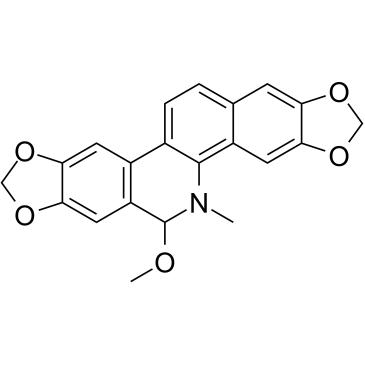
-
GC35178
6-Methoxykaempferol 3-O-Rutinoside
6-Methoxykaempferol 3-O-Rutinosid ist ein Naturprodukt, das aus den KrÄutern von Pilocarpus pennatifolius isoliert wird.
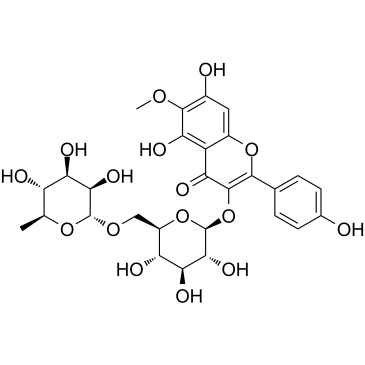
-
GC30179
6-ROX (6-Carboxy-X-rhodamine)
6-ROX (6-Carboxy-X-Rhodamin) ist ein fluoreszierender Oligonukleotidmarker, der als AkzeptormolekÜl fungiert, das an 5-FAM als Donor in der FRET-Bildgebung gekoppelt ist.
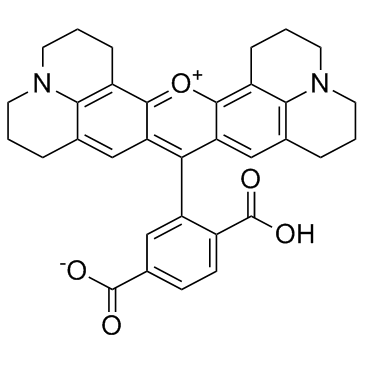
-
GN10228
6-Shogaol
Ein bioaktiver Bestandteil von Ingwer
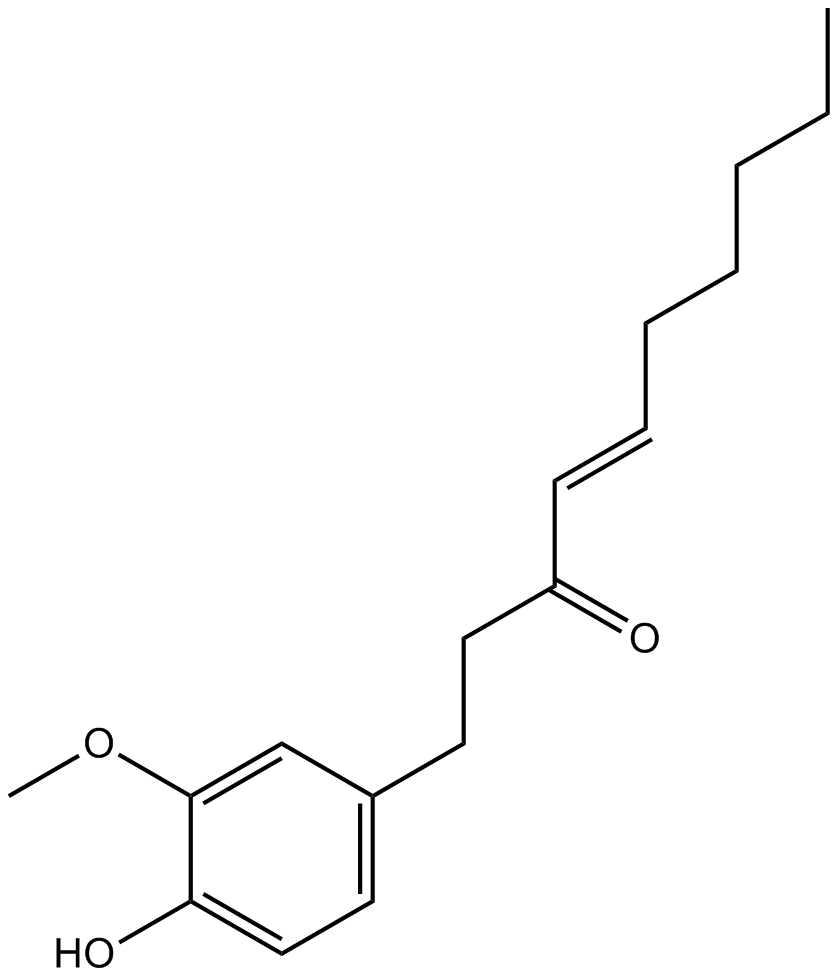
-
GC30342
6-TAMRA (6-Carboxytetramethylrhodamine)
6-TAMRA (6-Carboxytetramethylrhodamin) ist ein weithin verwendeter Fluorophor zur Herstellung von Biokonjugaten, insbesondere von fluoreszierenden AntikÖrpern und Avidinderivaten, die in der Immunchemie verwendet werden.
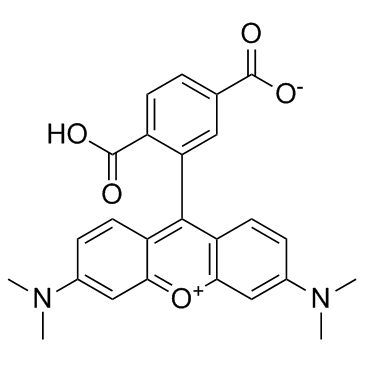
-
GC30142
6-TAMRA-SE (6-TAMRA-NHS ester)
6-TAMRA-SE (6-TAMRA-NHS-Ester) (6-TAMRA-NHS-Ester) ist ein Fluoreszenzfarbstoff, der die Amin-reaktive Gruppe trÄgt.
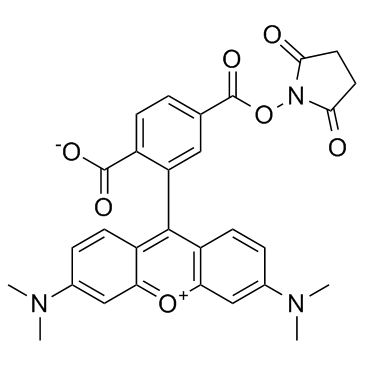
-
GC40419
7β-hydroxy Cholesterol
7β-hydroxy Cholesterin ist ein Oxysterin, das durch die Oxidation von Cholesterin entsteht.

-
GC46080
7,3',4'-Trihydroxyflavone
7,3',4'-Trihydroxyflavon ist eine Flavonoid-Aglycon-Verbindung, die aus Ackerbohnenschoten isoliert wird.

-
GC33869
7,4'-Di-O-methylapigenin (4',7-Dimethoxy-5-Hydroxyflavone)
Die Verbindung 7,4'-Di-O-methylapigenin (4',7-Dimethoxy-5-hydroxyflavone) kann teilweise fÜr die berichtete antimykotische AktivitÄt von C.
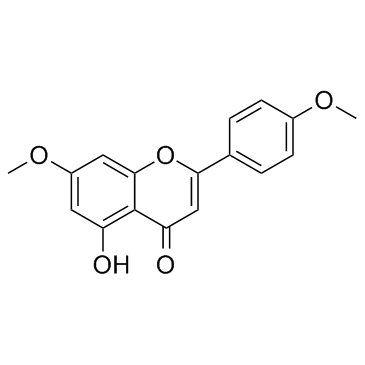
-
GC35186
7,8-Dimethoxycoumarin
7,8-Dimethoxycumarin (Daphnetindimethylether) ist ein Cumarin aus Artemisia caruifolia.
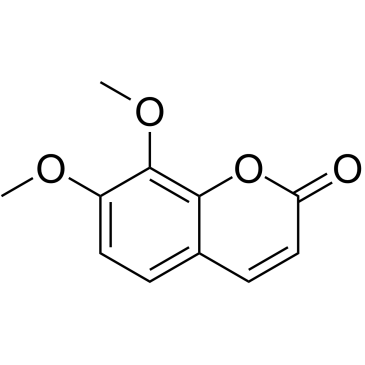
-
GC15096
7-Amino-4-(trifluoromethyl)coumarin
7-Amino-4-(trifluormethyl)cumarin (Cumarin 151) ist ein Fluoreszenzmarker zum sensitiven Nachweis von Proteinasen.
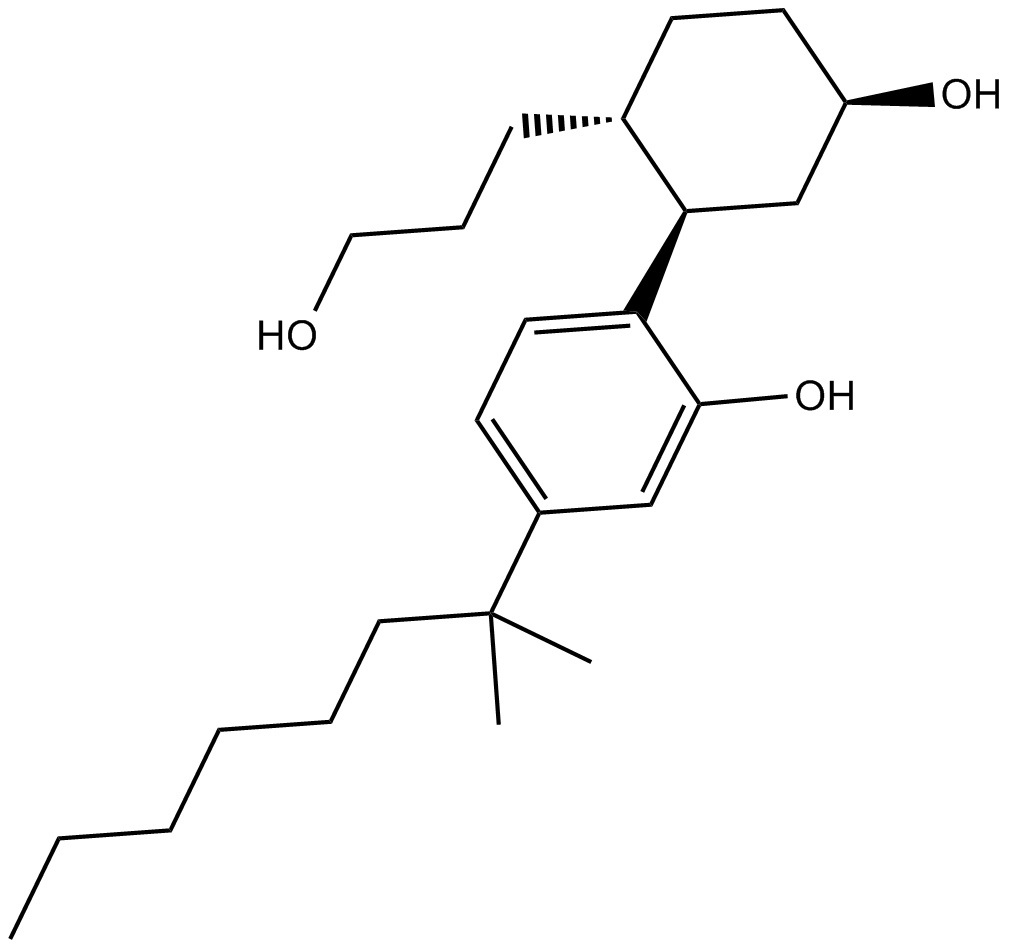
-
GC48757
7-dechloro Griseofulvin
A polyketide with fungicidal and plant growth inhibitory properties

-
GN10625
7-Epitaxol
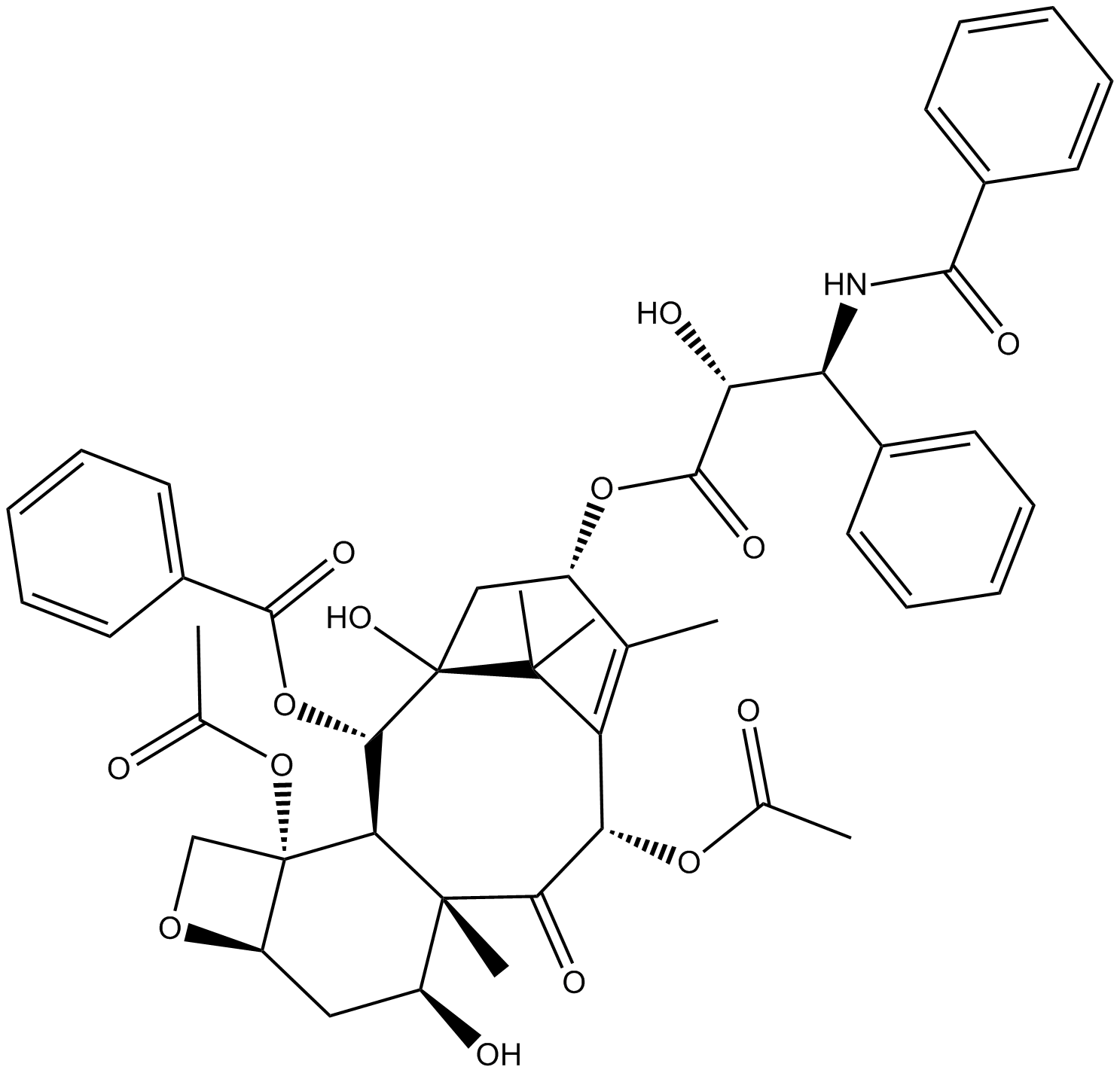
-
GC60537
7-Ethoxyrosmanol
7-Ethoxyrosmanol ist ein phenolisches Diterpen, das aus Salvia chamelaeagnea isoliert wird. 7-Ethoxyrosmanol hat antioxidative AktivitÄt in vitro und Antitumorwirkungen auf Neuroblastomzellen.
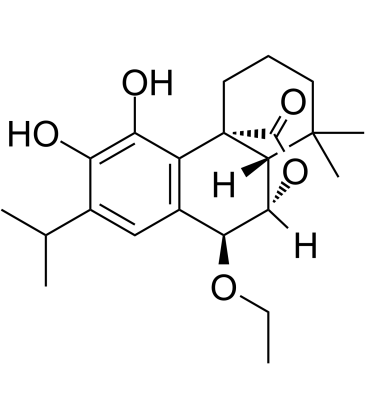
-
GC46737
7-Hydroxy-4-methyl-8-nitrocoumarin
7-Hydroxy-4-methyl-8-nitrocumarin ist ein Cumarinderivat.

-
GC42613
7-methoxy Apigeninidin (chloride)
A 3-deoxyanthocyanin

-
GC48880
7-Methoxyflavone
7-Methoxyflavon ist eine aus Zornia brasiliensis isolierte Verbindung.

-
GC60032
7-Methoxyrosmanol
7-Methoxyrosmanol (7-O-Methoxyrosmanol), ein aus Rosmarin isoliertes phenolisches Diterpen, unterdrÜckt die cAMP-ReaktionsfÄhigkeit von PEPCK- und G6Pase-Promotoren.
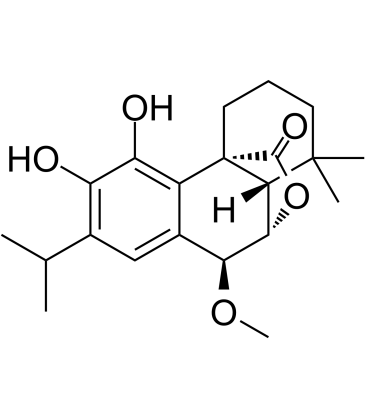
-
GC65409
7-Methylcoumarin
7-Methylcumarin, ein Cumarin, weist eine starke hepatoprotektive AktivitÄt und eine starke antioxidative Wirkung auf.
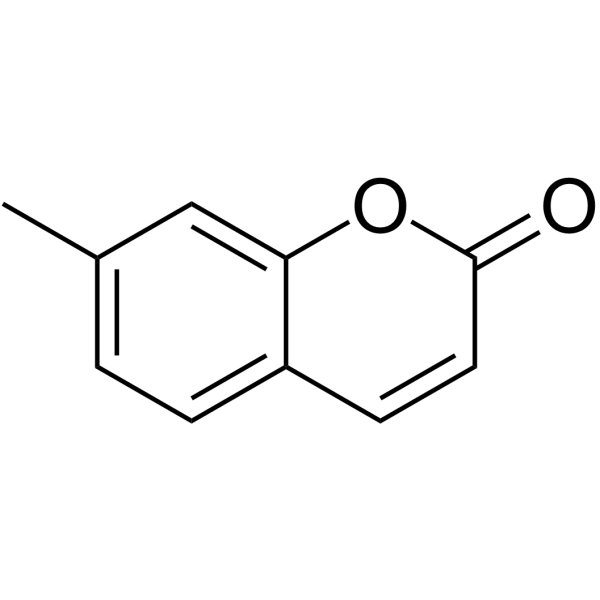
-
GN10174
7-O-ethyl-morroniside
